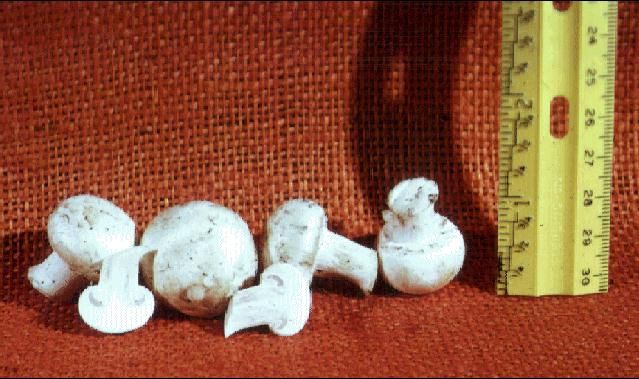Mushroom—Agaricus bisporus (Lge.) Sing.1
The mushroom is a fungus that grows upon decaying organic matter. Fungi, including mushrooms, are incapable of producing their own food. They cannot use the energy of sunlight as green plants do. Their food consists of carbohydrates and proteins produced during the fermentation and decomposition of organic material.

Credit: UF/IFAS
Description
The most commonly cultivated mushroom in the United States is A. bisporus. Its several strains vary in growth habit, color, yielding ability, and other characteristics. The most common variation occurs in color, and three groups; the whites, creams, and browns are recognized. Actually, the cultivated mushroom is a horticultural adaptation of the common field mushroom that is found in pastures and grassy places.
The main body of the fungus is the mass of fine, thread-like, white growth that can be seen throughout the composted material on which the mushroom is feeding. This mass of absorbing vegetative parts is called mycelium. The edible part of the mushroom is the toadstool, the fruiting body or reproductive part of the plant.
The edible reproductive part consists of a stem and cap. Gills, found on the underside of the cap, are arranged somewhat like spokes in a wheel. The gills bear multiple spores that start new plants. When the mushroom first appears above ground, it looks like a button, so the smaller harvested ones are called button mushrooms.
A spore is an asexual seed that contains no endosperm. In order to produce a plant, a spore must land on some kind of organic material that is in the right stage of decomposition to provide food for the germinating spore.
Culture
Mushrooms grow best in a moist, cool, well ventilated place. Temperatures need to be controlled within a range of 50°F–70°F. Relative humidity must be maintained above 70% or mushrooms may dry out and split.
Compared with the culture of other vegetables, the production of mushrooms is fairly complicated. Mushrooms are best grown indoors in trays or beds filled with an organic planting medium (compost). Horse manure has long been used, but other materials are suitable. Some materials that have been used alone or in combination with horse manure are alfalfa hay, corncobs, cornstalks, straw, sawdust, dried brewer's grains, and poultry manure. The following are the usual steps taken to grow mushrooms.
Trays are filled with fresh compost, which is allowed to ferment at 140°F for 4 to 6 days (or until odor of ammonia disappears). Trays are then moved to a well-ventilated, 75°F–80°F room for spawning (planting spores).
Spawn is the propagating material for mushrooms. It contains spores mixed with spawning materials such as manure, tobacco stems, or grain. Spawn is most often purchased from specialty spawn makers. Spawn is planted either by the broadcast method or by planting in small pieces 1½ inches deep at 10-inch intervals. With temperatures held at 75°F, the growth from the mushroom spawn spreads through the upper 3 inches of the bed of compost.
After 2 to 3 weeks of growth, a 1-inch layer of casing soil is spread over the surface of the bed. Generally, a not-too-sandy loam is preferred. The casing soil helps hold in gasses.
After casing, trays should be maintained at 50°F–62°F and kept sprinkled with water until the first tiny mushrooms appear in about 3 to 4 weeks. After that, watering is done only as needed.
Picking may commence at the first signs of buttons, and last for 6–7 weeks or longer. Each mature mushroom is between 1 and 2 inches in diameter. Harvesting may be done daily or every few days, depending on sprouting.
Small home units may be started by purchasing ready-to-grow kits from major vegetable seed companies. Larger quantities of spawn are available from some of these seed companies and from specialty companies.
Shiitake Mushrooms
Another kind of mushroom gaining in popularity in the U.S. both from a production and use standpoint is the Shiitake (Lentinus edodes). This is the major edible mushroom grown in Asia. Shiitakes are grown by inoculating mushroom spawn into holes drilled into suitable species of hardwood logs. In Florida, various species of oaks (especially the black-jack oak) have proven most satisfactory.


